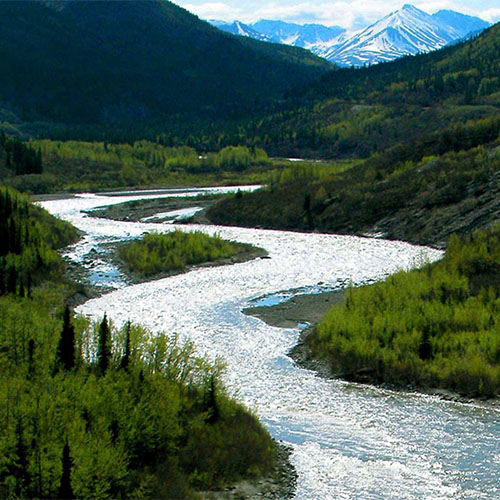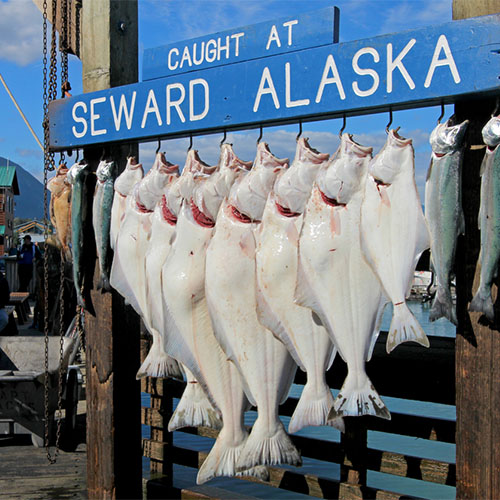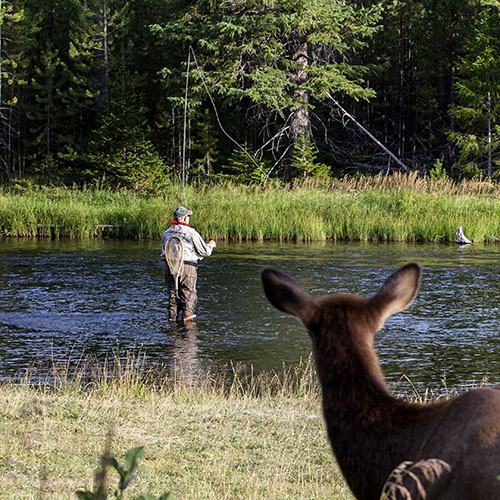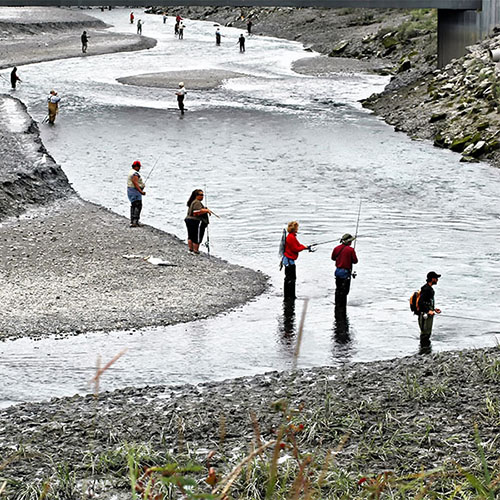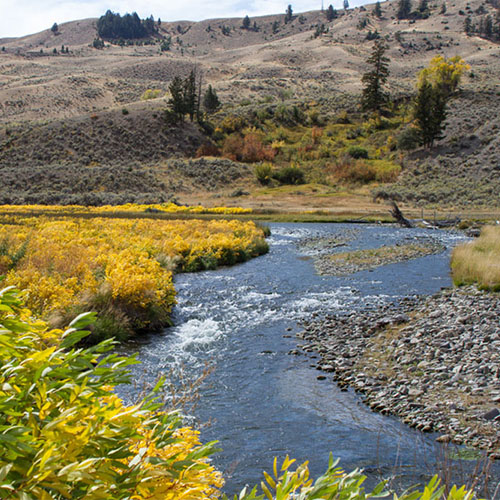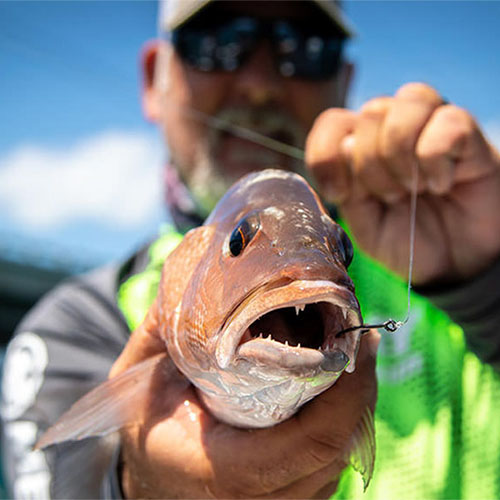Pickwick Lake provides beginning and experienced anglers a variety of excellent sportfishing opportunities. Pickwick is recognized for its trophy winning smallmouth bass, largemouth, spotted bass and catfish. The Wilson Dam tailwater region of Pickwick Lake is a top fishing destination. The discharge basin at Colbert Fossile Plant, due west of Sheffield city, is another fishing hotspot. The basin attracts fish and fisherman year round.
Pickwick Lake lies in three states: Tennessee, Alabama, and Mississippi. There is a reciprocal license agreement in place between these states that allows anglers to fish within Pickwick impounded waters using a sport fishing license obtained from any of the participating states. However, anglers must abide by the regulations of the state where they’re fishing. The impoundment includes all waters from Pickwick Dam (TRM 209) upstream to the Bear Creek Tennessee River confluence (TRM 225).
An Alabama, Mississippi, Tennessee fishing license is all that’s needed to explore 50 miles and 47,500 acres of Pickwick Lake waters. From one of the many boat ramps, motor or paddle out to your perfect fishing spot. There is also ample bank access for shore casting.
Top Fishing Spots on Pickwick
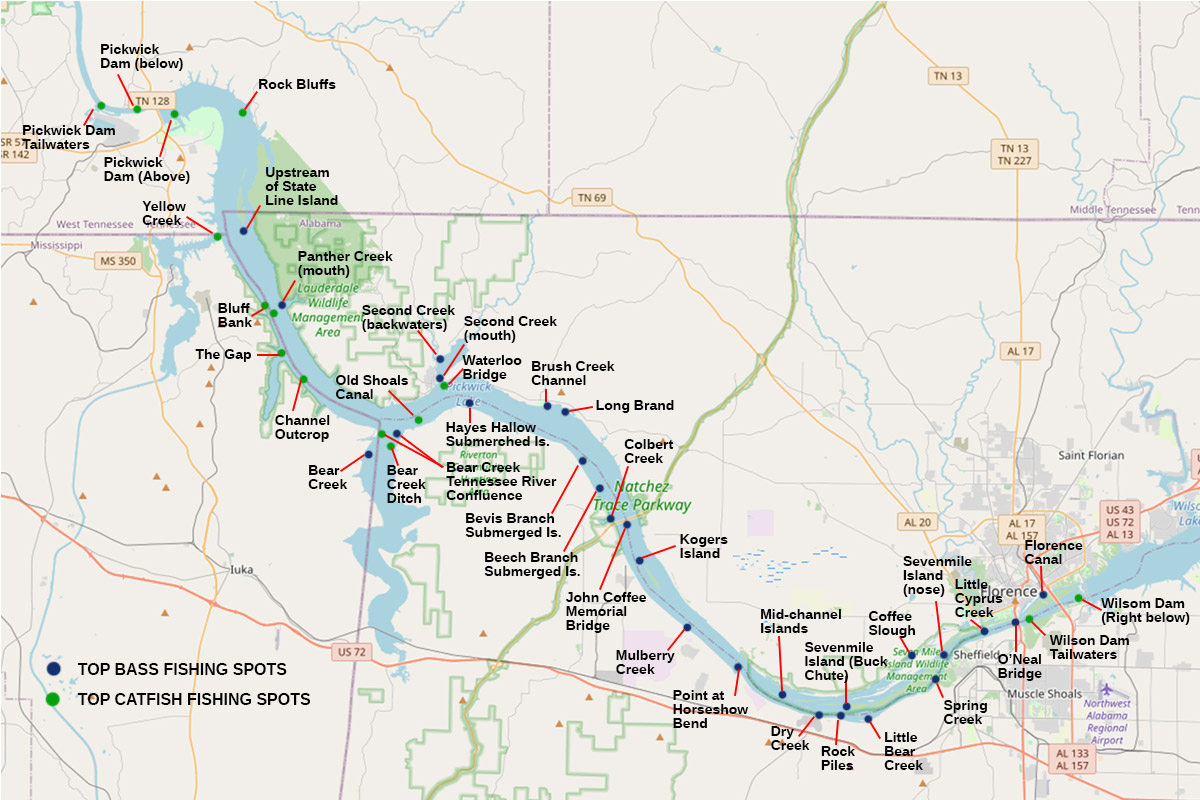
Pickwick lake has a maximum depth of 85 feet. Many of the deeper holes, humps and riverine stretches provide excellent fishing for large catfish and bass. If bass is the target tablefare, you’ll find the perfect size specimens holding along the weed margins and shorelines. There are deep water attractors installed throughout the lake that are marked with buoys. Attractors are designed to concentrate fish for anglers and are a great place to start your fishing adventures if you’re new to the lake.
The upper portion of Pickwick that runs through Alabama is more of a river than a lake. It holds abundant populations of largemouth and smallmouth bass. Target the current breaks and shallow bars with spinnerbaits or jigheads with a crawfish trailers and you’ll reel in some decent size smallmouths. Fishing along the upper portion of Pickwick up to Wilson Dam is excellent for bass, catfish and Sunfish.
The tailwaters just below Wilson Dam provides some of the best fishing opportunities on Pickwick. During the summer you’ll find high concentrations of channel catfish and blue catfish. During the winter Wilson Dam tailwaters provide anglers a rare opportunity to target sauger as they migrate upstream to spawn. You can fish the tailwaters by boat or from shore. There is ample bank access for fishing Wilson tailwaters along the south side of the river at Sheffield or at the north side from McFarland Park.
One of the best times to fish Pickwick Lake is when Tennessee Valley Authority (TVA) opens the turbines on the dams to generate electricity. When this happens, the dam gates are open and water rushes into the Tennessee River disloding aquatic insects, crustaceans, and—which in turn sets off a feed frenzy for bass.
If you’ve come to Pickwick to fish largemouth, smallmouth or striped bass, you’re not alone. Pickwick offer some of the best black bass fishing anywhere in the nation. The following chart lists top spots for bass activity and fishing on Pickwick. This is by no means a comprehensive list, but these spots regularly produce catches.
| Fishing Spot | Description / Coordinates |
|---|---|
| Upstream of State Line Island | Provides good year round fishing for smallmouth, largemouth, and striped bass. View map |
| Panther Creek Mouth | Bass and catfish feed on baitfish at the confluence of the main channel and Panther Creek. Fish the edges and point. View map |
| Bear Creek | Great pocket to fish during spring (Mar-May). Good bass and crappie fishing along the western shore of the channel pre-spawn. View map |
| Bear Creek Tennesse River Confluence | Bass and catfish hold at the confluence to ambush baitfish moving from the main channel into the creek. View map |
| Second Creek Mouth | Catfish move from the main channel into the mouth of Second Creek to feed and spawn in the spring. View map |
| Second Creek | The slower waters of the back area of Second Creek is a favorite spawning ground for laremouth bass during the spring. Fish spinners, soft plastics, an buzzbaits. View map |
| Hayes Hollow Submerged Island | Fish the trough on the back side of the hump for bass and catfish. View map |
| Brush Creek Channel | Great spot for fishing bass and sunfish. View map |
| Long Branch | Great area for targeting a variety of bass and other fish species. View map |
| Bevis Branch Submerged Island | Fish the downstream side of the submerged island. View map |
| Beech Branch Submerged Island | Fish the downstream side of the submerged island. View map |
| Colbert Creek | Bass move out of the main channel current into the mouth of Colbert Creek to forage. Fish along the edges and point. View map |
| John Coffee Memorial Bridge | The waters near John Coffee Memorial Bridge are productive for fishing bass and catfish. View map |
| Kogers Island | Fish the downstream end of Kogers Island. Fish hold here to seek shelter from the stronger current in the main channel. Great fishing spots for largemouth, smallmouth and striped bass. The southwestern edge provides some great structure that attracts bass. View map |
| Mulberry Creek | Bass move out of the main current and hold at the mouth of Mulberry Creek. View map |
| Point at Horseshoe Bend | A favorite fishing spot among locals. Has produced some large catches over the years. During the hotter months fish will often move up into the cooler waters of the creek. View map |
| Mid-channel Islands | The back edges of these islands often hold a lot of bass. Crankbaits that mimic shad, spinners and Rat-L-Traps produce well. View map |
| Dry Creek | Bass move out of the main current to forage at the mouth of Dry Creek and Pompey Creek. Fish along the edges and points. View map |
| Rock Piles | The back edges of the rock piles located along the southern bank a few hundred yards downstream from Buck Island provide for some great bass fishing. Jigs and slow-rolling spinnerbaits will produce action. View map |
| Sevenmile Island (Buck Island Chute) | The downstream end of Sevemile Island, also referred to as Buck Island Chute, provides excellent fishing for largemouth, smallmouth, and striped bass. This area is a bit sheltered from the main channel current and usually holds schools of baitfish that bass feed on. View map |
| Little Bear Creek | Hotspot for bass fishing during the summer months when current is strong and water is warmer. You'll also find bass holding in the shallows during spring spawn and cooler fall months. View map |
| Spring Creek | The mouth of Spring Creek provides a rest and forage area for bass. Bass often congregate here when main channel current is strong and the weather is hot. Fish back into the shallow waters of the creek during spring and fall to target spawning and foraging bass. View map |
| Coffee Slough | The slower moving water of Coffee Slough is a favorite spawning ground for largemouth bass during spring. This is a prime sport for targeting largemouths. View map |
| Sevenmile Island (Nose) | When water is being released upstream from Wilson Dam the nose of Sevenmile Island turns into a hotspot of bass activity. Target largemouth bass fishing spinnerbaits off the dropoffs, jig-and-pigs to target smallmouths, and top-water lures for the stripers. View map |
| Little Cyprus Creek | The deep channel that runs along little cyprus creek often holds a variety of bass. Fish from the mouth of the creek back for largemouth, smallmouth, and striped bass. View map |
| O'Neal Bridge | Various fish species use the bridge pilings for cover. Good location to target largemouth, smallmouth and and occassional striper. View map |
| Florence Canal | The Florence Canal just downstream from Wilson Dam is a hotbed of smallmouth activity. There are smallmouth bass here year round, but spring spawn is the best time to target smallmouths as they migrate towards the dam. View map |
| Pickwick Dam (Below & Tailwaters) | Below Pickwick Dam and in the tailrace section is some of the best fishing for stripers. View map |
Most anglers fish Pickwick for black bass, and that’s what it’s known for—but slightly less well-known is that Pickwick is one of the top destinations in the Southwest for catching Channel cats, Blue catfish and Flathead catfish. The following chart lists a few of the top spots for targeting catfish on Pickwick Lake.
| Fishing Spots | Description/Coordinates |
|---|---|
| Bear Creek Ditch | Fish the gravel bottom of the ditch that runs north and south along the east side of Bear Creek. Target the base of the ditch along the dropoff at a depth of about 20 feet. Slow troll bait about 12-18" off the bottom. View map |
| Bear Creek Tennessee River Confluence | Where the old bear creek channel meets the Tennessese River main channel is a hotbed of catfish activity. During spring catfish move from the main channel into the creek to spawn. During early March is the perfect time to start hiting this area for catfish. Slow trolling about 12-18" off the bottom is a preferred technique. Drifting the edge of the channel is also productive. View map |
| Old Shoals Canal | Deep hole that reaches a depth of about 40 to 50 feet. When current is strong, from upstream drift fish over the hole bouncing your bait off the bottom. If current is slow, anchor in one spot and vertical fish the edges of the hole. View map |
| Waterloo Bridge | Fish the gravel bottom in the impoundment north of the bridge for Channel and Blue catfish during spring spawn. Slow troll just above the bottom or bounce your bait off the bottom as you retrieve. View map |
| The Gap | The Gap is found at the mouth of Camp Hollow Creek. You'll find Channel cats, Blue catfish and Flathead catfish holding in the 50-foot wide channel of deep water through the gap. View map |
| 2 Miles upstream from the State Line | A couple miles upstream from the Alabama-Tennessee state line in about 50 feet of water the current hits a hump that is about 20 feet under the water. Behind the hump is a trough at a depth of about 35 to 40 feet. The trough extends down stream to the point of State Line Island. This is a great location to fish Blue catfish (and bass). View map |
| Bluff Bank | The are numerous bluffs throughout lower Pickwick Lake that are full of Channel catfish. This bluff is a favorite spring gathering spot for channel catfish who spawn in the cracks and crevices of the walls. Fish up against the bluff targeting the crevices that protrude above the waterline. Catfish hold in about 5-10 feet of water. View map |
| Channel Outcrop | A catfish holding spot a mile upstreams from the mouth of Camp Hollow Creek on the Mississippi (south) side of the river. There are numerous points and outcrops where catfish hold in the bottom contours near the current. View map |
| Wilsom Dam (Right below) | Great spot for fishing flathead catfish at night View map |
| Pickwick Dam (Above) | Offers excellent fishing for all catfish species in Pickwick Lake View map |
| Yellow Creek (Mouth) | The mouth of Yellow Creek is Blue catfish territory. All of yellow creek will produce nice catches. View map |
| Wilson Dam Tailwaters | The tailwaters below Wilson Dam hold Channel cats, Blue catfish and Flatheads. Fish the creek mouths and humps. View map |
| Rock Bluffs | The rock bluffs in the Tennessee section of Pickwick Lake offer great fishing for Blue catfish. Drift fish the bluffs toward the dam. View map |
What you’ll catch
Pickwick provides abundant fishing opportunities for a variety of game fish from sauger to paddlefish, but it’s best known for its bass fishing, specifically largemouth, smallmouth, and spotted bass. Bass are abundant and large. You’ll reel in a lot of “keepers” as well as a good percentage of larger bass in excess of 15 inches.
Largemouth bass
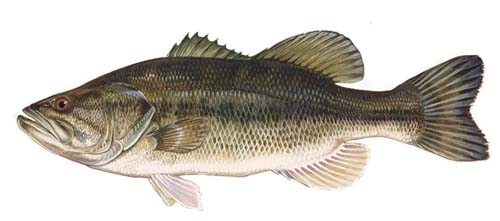
Largemouth bass are abundant year round throughout Pickwick Lake, although most quality catches occur in the spring. Average largemouths are around 2.5 pounds but trophy bass in the 5-8 pound range are a common catch. The minimum catch size for largemouths is 15 inches.
You’ll find most largemouth bass holding near cover, along weed margins, shorelines, channel drops, or suspending off ledges near deeper water. They’ll take a variety of artificial or live baits. Deep diving crankbaits, shad mimicking plugs, spoons, soft plastic worms, and jigs fished on a Carolina rig are some of the more popular presentations.
Target the hydrilla beds where large bass love to hold. Fishing a top water lure or crankbait over the top of the vegetation will often elicit a strike or coax a hungry bass into open water. Alternatively, allow your lure to sink into the grass and then give it a quick pop up. As the lure pops up out of the vegetation strikes often occur.
A few top spots for targeting largemouth bass include the area along the rock walls at the mouth of Dry Creek, Pompey Branch and Winn Springs.
Smallmouth bass
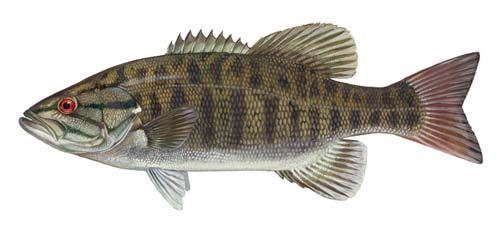
Pickwick Lake is legendary for consistently producing trophy smallies year after year. Average smallmouths are just over 2 pounds but several in the 10 pound range have been pulled out of Pickwick Lake over the years. I wouldn’t doubt there are even bigger specimens waiting to be caught.
Most smallmouth bass in Pickwick are found in deeper water—and they tend to move around. They are not as predictable in their movement patterns as largemouth bass and require a bit more searching. Knowing the contour of the area your fishing or using a good sonar system is often required to find where they’re holding.
During warmer months night fish for smallies on Pickwick Lake is popular.
During March Smallmouth bass begin to move from the depths of Pickwick Lake into the shallows of the tailwaters to spawn. Typical spawning depth is about 5 to 8 feet. You won’t see spawning smallies, but they’re there. Post-spawn smallies move from tailwaters and disperse throughout the lake to deep points, ledges and areas with rock structure.
Spinnerbaits, wakebaits, rat-l-traps and baits that mimick shad are some of the most effective presentations for targeting smallmouths on Pickwick. As waters warm, more active presentations, including small crankbaits and finesse jigs with curly tail soft plastics are popular.
Hotspots for targeting smallmouth bass post-spawn include the islands upstream of Dry Creek and the deep embayments on the north side of the lake just down from Wilson Dam. Target the channels, rocky shoals, and other current obstructing structure. Where largemouths stick to the weeds, smallmouths prefer the current and rocks.
Spotted bass
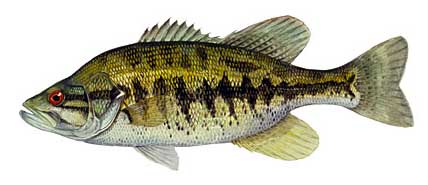
There’s always a lot of talk about the quality of fishing for trophy-sized smallmouth and largemouth bass in Pickwick, but seldom do you hear anglers raving about spotted bass fishing on the Pickwick Lake. Spotted bass exist on the lake but in far fewer numbers than either smallies or largemouths. You’ll find spotted bass in many of the same hideouts and areas as smallmouth bass.
Striped Bass & Hybrid Striped Bass
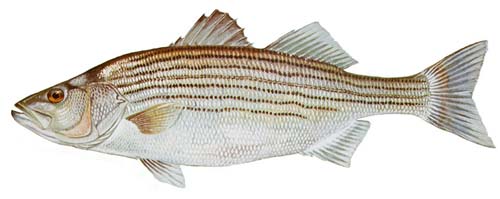
Striped Bass (aka “Stripers”) are found throughout Pickwick Lake. You’ll find stripers sporadically from Wilson Dam downstream to Pickwick Dam past the Tennessee border. When targeting stipers on Pickwick proper fish the current and deeper water.
Most striped bass fishing occurs in the tailwaters below Pickwick Dam. This technically isn’t part of Pickwick Lake, but it’s where you’ll find the anglers that are serious about reeling in some serious stripers.
Stripers in the tailwaters of Pickwick Dam can reach of to 80 pounds, but average catches are in the 10 to 15 pound range and 10 to 20 inches long. Stripers can be fished here year round but prime striper season is from March through early November.
Probably the most popular techique for fishing stripers in the dam’s tailwaters is drifting live shad minnows. During early March when shad aren’t yet available, anglers will target stripers using deep-diving crankbaits and shad imitation soft plastics such as the Sassy Shad or paddle tail swimbait.
During April and May you start fishing live minnows. Yellowtail shad and hickory shad (skipjacks) are preferred baits. You can use a small bait-catcher style rig to fill up your livetanks with striper bait.
White bass
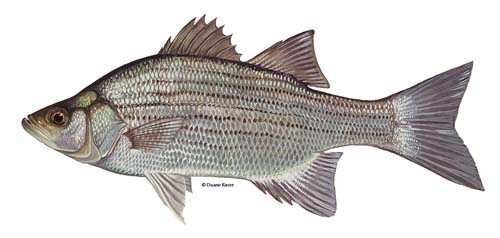
White bass is a common fish that is plentiful throughout Pickwick Lake. Due to their abundance, they’re often overlooked by many anglers who are more interested in catching smallmouth and largemouth bass. When fishing for smallmouths and largemouths is slow, fising for White bass is a great alternative.
White bass like current. Target White bass in current in the middle of the main channel. Fish humps and underwater American indian mounds. This is where shad congregate and where you’ll find White bass. Anglers also report having success targeting White bass at the upstream ends of underwater islands and mounds.
Cast and retrieve is an effective technique for fishing White bass. Cast your bait, let it fall to the bottom, then bounce it along the bottom as your retrieve. White bass will take a number of artificial lures, including spinners, but they love life minnows, shad and baitfish.
You can fish White bass using a 4- to 6-pound test line, but using a stronger line will ensure you don’t lose your bait or snap your line when a larger hybrid or striper strikes.
Crappie
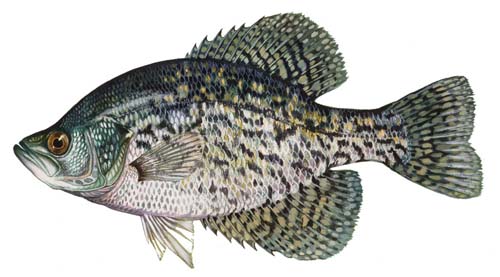
Pickwick is an excellent crappie fishery. A known crappie hotspot is Yellow Creek but you’ll find both black crappie and white crappie all the way from Wilson Dam in Alabama downstream to Pickwick Dam in Tennessee. During the warmer months expect crappie to be holding in about 20-25 feet of water. As winter turns into spring and summer turns into fall crappie move into the shallows.
One of the more productive techniques for fishing crappie on Pickwick is vertical jigging a 1/8 oz to 1/4 oz jig near stump fields and along deeper ledges. Stick with a smaller size jig unless the wind picks up and you need a little more weight to get your bait down. Fishing a tiny tube jig tipped with a worm will reel in crappie as well.
Crappie holding areas can change from year to year. Your best friend for finding and fishing crappie is going to be your electronics. A good fishing find can help you relatively quickly find holding areas.
Channel catfish
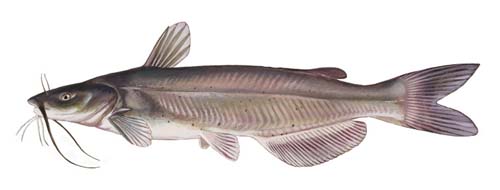
There are thousands of channel catfish in Pickwick Lake. Channel cats can get up to 15 pounds, but average catches will be in the 1.5- to 3-pound range.
Channel cats are typically found at shallower depths than Blue or Flathead catfish. During mid summer, a depth of 5-10 feet is where most Channel catfish are found.
Anglers report fishing a 1/0 Foley spoon tipped with a shrimp or cut bait at the base of bluff ledges bouncing it off the bottom as you retrieve is one of the more effective presentations for catching Channel cats on the lake. Channel cats will also take chicken livers and stink baits you can pick up at most tackle shops.
Blue catfish
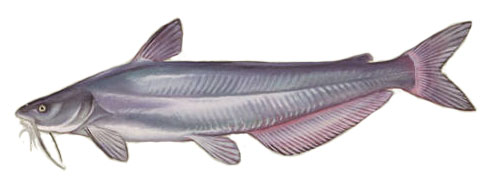
All three species of catfish are abundant on Pickwick Lake, but Blue catfish are the most coveted by anglers. Average catches are between 10 and 15 pounds but hooking a 50 pound plus lunker is not uncommon. The record catch for Blue catfish on Pickwick lake is over 111 pounds. Reeling in a lunker Blue is quite the experience but smaller catfish make better tablefare.
The best time to target Blue catfish is just before and during spawn on the stump and mud fats. Post-spawn you’ll find Blue catfish along the main river ledges. During mid to late summer Blue catfish can be caught at depths between 5-10 feet along the numerous gravel bars on the upper end of the lake. On lower end of Pickwick, Blue’s are often found on the flats as deep as 20 feet. During winter months target the riverine sections at the upper end of the lake.
Anglers report higher concentrations of Blue catfish from the Mississippi-Tennessee state line to the Pickwick Dam. Fish the ledges and fisures along the main channel. Also, hit the holes and pockets.
Blue catfish can be fished using a traditional cast and retrieve technique, slow trolling or a controlled drift. A common presentation is a three-way rig using a 2′-3′ leader and 5/0-7/0 circle hook baited with chunks of skipjack, shad, chicken liver, shiners, shrimp or large nightcrawlers. Jug fishing on the open flats is another common method for targeting catfish n Pickwick.
A few hotspots include the flats behind State Line Island and the humps at mouth of Indian Creek.
Flathead catfish
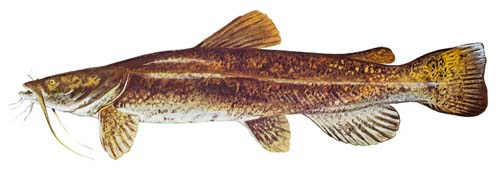
Flatheads are not as common on Pickwick lake as Channel cats or Blue catfish, but they’re still abundant. Two of the best spots to target flathead catfish are the headwaters of Pickwick just behind Wilson Dam and the tailwaters below Pickwick Dam at the west end of the lake.
Anglers report one of the best methods for fishing flatheads is target them at night using a large baitfish such as a bluegill or gizzard shard. Wait until after dam operations have shut down around 11pm. Attach your baitfish under a slip bobber rig and fish it at a depth of about 20 to 25 feet. This should put your bait about 5 feet off the bottom. Cast your rig rig up against the dam and let it drift back to you. Flatheads will come up from the depths and take your bait.
Sauger
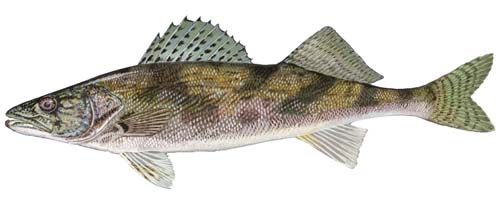
While not as common as bass, sunfish or catfish, sauger are still found scattered throughout Pickwick Lake. During the summer they usually hold in deeper water. The best time to target sauger is actually during their winter migration—from December through February—in the tailwaters of Wilson Dam.
Sauger are also abundant in the tailwaters of Pickwick Dam in Kentucky Lake.
A simple yet effective presentation for fishing Sauger is a 1 oz. jig tipped with a larger shiner fished on the bottom. Sauger can also be caught using crankbaits.
A first cousin to the Sauger, walleye are present in small numbers in Pickwick Lake, but sightings are rare. Pickwick is part of a river system that does have walleye in it.
Sunfish

Bluegills and Redear are the two most common species of sunfish found on Pickwick lake. The lucky angler will also snag a Redbreast sunfish once in a while as well. Sunfish are the most abundant game fish species in the Pickwick Lake fishery.
During the spring sunfish bed down on the shallow flats to spawn. The rest of the year they can be found at various depths but almost always near cover. Average Bluegill weight just over 1/3 of a pound. Redears are slightly bigger at 1/2 a pound. With the exception of Redears, there is no creel or length limit for sunfish. The catch limit for Redear Sunfish is 20 per day and there is no length limit.
The best time of year to target Sunfish is late March through end of June. Fish the open flats and near brush piles. A jig head tipped with a worm or cricket is the perfect bait for catching Sunfish. Other popular presentations include a waxworm on a #6-10 hook using a split shot rig, 1/8 to 1/4 oz. jig worked along the bottom, or a spinner with a plastic grub. There are a variety of spinner styles. One of my favorites is a safety-pin-style lure with a jig, grub, or other lure. A Road Runner is also effective.
The waters near Dry Creek and Wing Springs offers great fishing for bluegills, readears and other other Sunfish species.
Muskellunge
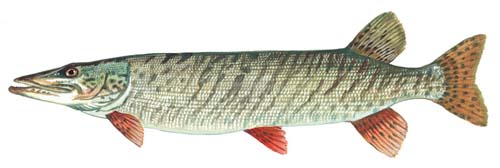
An Alabama state record muskellume was pulled from the tailwaters of Wilson Dam in Pickwick Lake in 1972 by Steve Leatherwood. This fish is no longer stocked in Alabama. It is believed the Muskies still exist in Pickwick Lake but catches are rare.
Paddlefish

An Alabama state record paddlefish was caught in the tailwaters of Wilson Dam in Pickwick Lake in 1982 by Susan Holland. Paddlefish are still found in Pickwick Lake but catches are not common.
The Best Baits and Tactics—Hands Down!
The baits, tactics and presentations for fishing Pickwick Lake are a varied as there are fish in the lake. The following chart lists the most productive baits and techniques reported by anglers for catching the most popular sportfish species.
| Fish Species | Recommened Baits & Techniques |
|---|---|
| Smallmouth Bass | Shallow crankbaits, rat-l-traps, spinnerbait (double willow leaf blade), jigs and soft plastics that mimic shad fished in deep embayments, channels, rocky shoals and near current. Live bait including shad and minnows are very effective |
| Largemouth Bass | Deep diving crankbaits, lipless crankbaits, plugs, spoons, soft plastics and jigs fished near cover, ledges and weed margins. Live bait including shad and minnows are very effective |
| Spotted Bass | Spinnerbaits, wakebaits, Rat-L-Traps and shad imitations in deep embayments, channels, rocky shoals and near current. |
| White Bass | Spinners, shad imitations and live baitfish (minnows/shad) cast and retrieved along the bottom |
| Striped Bass / Hybrid Striped Bass | Live shad minnows, deep diving crankbaits, swimbaits (paddle tail) and shad imitations drifted |
| Sauger | Target tailwaters of Wilson and Pickwick dams in winter using 1 oz. jig tipped with a shiner/minnow fished along the bottom |
| Blue Catfish | Chunks of skipjack, shad, shiners, shrimp, nightcrawlers or chicken liver on a 5/0-7/0 circle hook or 3-way rig fished near gravel bars, flats, and riverine sections |
| Channel Catfish | 1/0 Foley spoon or 2/0-5/0 circle hook tipped with chicken livers or stink bait fished in 5-10 feet of water fished at the base of bluff ledges |
| Flathead Catfish | Target at night in headewaters of Wilson and Pickwick Dams with large bait fish (bluegill, gizzard shad) on slip bobber rig at a depth of 20 to 25 feed |
| Crappie | 1/8 ot 1/3 oz jig or tube jig tipped with a worm vertically jigged near stump fields, cover and along ledges |
| Sunfish | 1/8 to 1/4 oz. jig head tipped with a worm or cricket using a #6-10 hook on a split shot rig or safety-pin-style lure with a jig or plastic grub worked along the bottom |
Fishing Regulations
The Alabama-Mississippi-Tennessee reciprocal license agreement allows anglers to fish Pickwick Lake waters within the borders of any state with a fishing license obtained in Alabama, Mississippi or Tennessee. ( Source: Tennessee Wildlife Resource Agency)
Each state has its own fishing regulations that anglers must follow. The following chart provides fishing regulations by state for Pickwick Lake.
| Tennessee | Mississippi | Alabama | |
|---|---|---|---|
| Largemouth/Smallmouth/Spotted Bass | 5 per day max combined | 10 per day max combined | 10 per day max combined (No more than 5 smallmouth) |
| Largemouth Bass | 15 inch min length | 15 inch min length | 15 inch min length |
| Smallmouth Bass | 15 inch min length | 15 inch min length | 15 inch min length |
| Spotted Bass | No length limit | 15 inch min length | |
| Crappie (all species) | 30 per day max; 9 inch min length | 30 per day max; 9 inch min length | 30 per day max; 9 inch min length |
| Catfish (Blue, Channel, Flathead) | For fish over 34 inch creel limit 1 per day; no limit for fish under 34 inches | 1 catfish per day over 34 inches may be harvested; no creel limit under 34 inches | 1 catfish per day over 34 inches may be harvested; no creel limit under 34 inches |
| Striped/Hybrid Striped Bass | 2 per day max combined | 6 creel limit per day: 15 inch min length | 15 per day; No more than 5 may exceed 22 inches |
| White Bass | 15 per day; no length limit | - | 15 per day |
| Yellow Bass | No creel limit; no length limit | - | 15 per day |
| Walleye | 5 per day limit; 15 inch min length | 3 creel limit per day | - |
| Sauger | 10 per day limit; 15 inch min length | 10 creel limit per day | 5 per day limit; 15 inch min length |
| Paddlefish | 2 per day limit; Culling prohibited | Creel limit 0; all lengths must be released | Creel limit 0; all lengths must be released |
| Readear Sunfish | 20 per day limit; no length limit | Included in "Sunfishes" | Included in "Sunfishes" |
| Sunfishes (Bluegill, warmouth, etc.) | No creel limit; no length limit | Combined creel limit of 100 per day | Combined creel limit of 50 per day |


